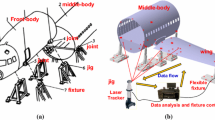Abstract
During the final assembly process, finding a best fitting resolution for gap and flush between assembled parts is the main object. This paper divides these fitting problems into two optimization stages, which are attitude fitting and position fitting, and proposes a mixed model which combines the Gaussian Imaging method (Enriched Complex Extended Gaussian Imaging) and even fitting algorithm (Hausdorff distance based criteria). It is illustrated that Gaussian Imaging method can be used to orient two similar curve objects and therefore accelerate the optimization process by the even fitting method. We also demonstrate the model by fitting a 2D classic case, an automobile door fitting into a frame, and generalize the application of the model into 3D curve fitting by fitting a simple automobile lamp into an auto-body. The best rotation and translation is found by using two curve objects’ similarity in attitude and minimum width in gap and flush as criteria.






Similar content being viewed by others
References
Besl, P. J., & McKay, N. D. (1992). A method for registration of 3-D shapes. IEEE Transactions on Pattern Analysis and Machine Intelligence, 14(2), 239–256. doi:10.1109/34.121791.
Chua, C. S., & Jarvis, R. (1997). Point signatures: A new representation for 3D object recognition. International Journal of Computer Vision, 25(1), 63–85.
Dupinet, E., Balazinski, M., & Czogala, E. (1996). Tolerance allocation based on fuzzy logic and simulated annealing. Journal of Intelligent Manufacturing, 7(6), 487–497.
Fainberg, Z., & Zussman, E. (1999). Even fitting closed curves: 2-D algorithm and assembly applications. Journal of Manufacturing Science and Engineering, 121(2), 265–271.
Gavankar, P., & Bedworth, D. (1991). Stacked tolerance analysis and allocation using assembly models. Journal of Intelligent Manufacturing, 2(6), 365–377. doi:10.1007/bf01471939.
Horn, B. (1984). Extended gaussian images. Proceedings of the IEEE, 72(12), 1671–1686.
Hu, Z., Chung, R., & Fung, K. S. M. (2010). EC-EGI: enriched complex EGI for 3D shape registration. Machine Vision and Applications, 21, 177–188. doi:10.1007/s00138-008-0161-z.
Ikeuchi, K. (1983). Determining attiude of object from needle map using extended Gaussian image. Cambridge, MA: Massachusetts Institute of Technology Artificial Intelligence Laboratory.
Johnson, A. E., & Hebert, M. (1999). Using spin images for efficient object recognition in cluttered 3D scenes. IEEE Transactions on Pattern Analysis and Machine Intelligence, 21(5), 433–449. doi:10.1109/34.765655.
Kang, S. B., & Ikeuchi, K. (1993). The complex EGI: A new representation for 3D pose determination. IEEE Transaction on Pattern Analysis and Machine Intelligence, 15(7), 707–721.
Khodaygan, S., Movahhedy, M. R., & Foumani, M. S. (2011). Fuzzy-small degrees of freedom representation of linear and angular variations in mechanical assemblies for tolerance analysis and allocation. Mechanism and Machine Theory, 46(4), 558–573. doi:10.1016/j.mechmachtheory.2010.11.004.
Ko, K. H., Maekawa, T., & Patrikalakis, N. M. (2005). Algorithms for optimal partial matching of free-form objects with scaling effects. Graphical Models, 67(2), 120–148. doi:10.1016/j.gmod.2004.05.005.
Luo, L. J., Lin, Z. Q., & Lai, X. M. (2003). New optimal method for complicated assembly curves fitting. The International Journal of Advanced Manufacturing Technology, 21(10), 896–901.
Shah, J. J., Yan, Y., & Zhang, B. C. (1998). Dimension and tolerance modeling and transformations in feature based design and manufacturing. Journal of Intelligent Manufacturing, 9(5), 475–488.
Shen, Z., Shah, J. J., & Davidson, J. K. (2008). Analysis neutral data structure for GD & T. Journal of Intelligent Manufacturing, 19(4), 455–472. doi:10.1007/s10845-008-0096-2.
Tarel, J. P., Civi, H., & Cooper, D. B. (1998). Pose estimation of free-form 3D objects without point matching using algebraic surface models (pp. 13–21).
Wen-Feng, Z., & Jiang-Qi, Z. (2010). Optimal method for auto-body closure panel fitting using Hausdorff distance criteria. International Journal of Advanced Manufacturing Technology, 48(9–12), 1019–1029. doi:10.1007/s00170-009-2310-6.
Wu, S. K. (1991). A methodology for optimal door fit in automobile body manufacturing. Ph. D. Thesis. Ann Arbor, MI: Department of Mechanical Engineering and Applied Mechanics, The University of Michigan.
Yamany, S. M., & Farag, A. A. (1999). Free-form surface registration using surface signatures. In Proceedings of the 1999 7th IEEE international conference on computer vision (ICCV’99) (Vol. 2, pp. 1098–1104). Kerkyra: IEEE.
Yamany, S. M., & Farag, A. A. (2002). Surface signatures: An orientation independent free-form surface representation scheme for the purpose of objects registration and matching. IEEE Transactions on Pattern Analysis and Machine Intelligence, 24(8), 1105–1120. doi:10.1109/tpami.2002.1023806.
Yang, C., & Medioni, G. (1992). Object modelling by registration of multiple range images. Image and Vision Computing, 10(3), 145–155. doi:10.1016/0262-8856(92)90066-c.
Zou, Z., & Morse, E. P. (2004). A gap-based approach to capture fitting conditions for mechanical assembly. CAD Computer Aided Design, 36(8), 691–700. doi:10.1016/s0010-4485(03)00156-8.
Acknowledgments
This paper is fully supported by National Natural Science Foundation of China with Project Code 50905117 and No. 51121063, and also supported by the Programme of Introducing Talents of Discipline to Universities (No. B06012).
Author information
Authors and Affiliations
Corresponding author
Rights and permissions
About this article
Cite this article
Xiang, G., Hua, W. & Guanlong, C. Curve fitting optimization based on a mixed model for assembly applications. J Intell Manuf 26, 1113–1120 (2015). https://doi.org/10.1007/s10845-013-0843-x
Received:
Accepted:
Published:
Issue Date:
DOI: https://doi.org/10.1007/s10845-013-0843-x




